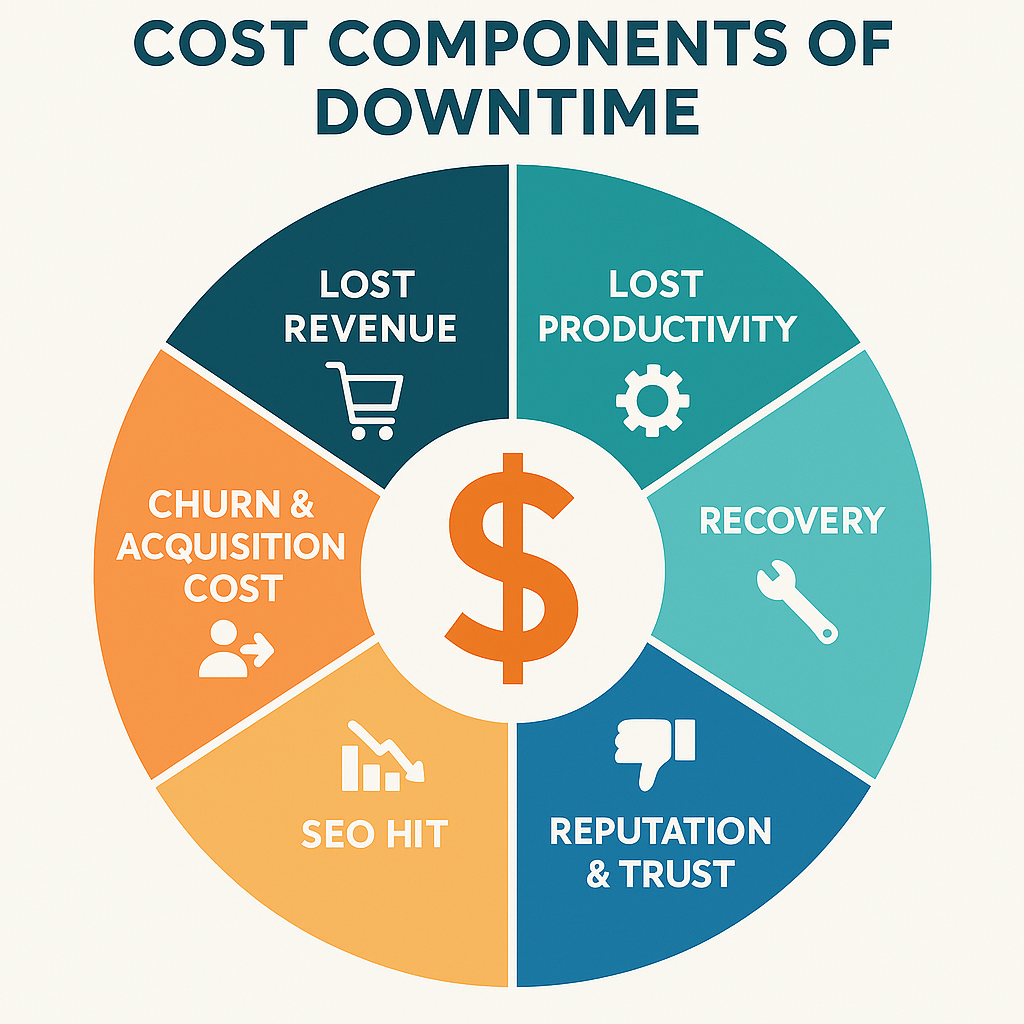Many business owners think of occasional downtime as a minor nuisance. But downtime isn’t just an inconvenience, it can have serious financial, reputational, and operational consequences. In this article, we’ll break down how much downtime really costs, including both direct and hidden losses, and show why investing in proactive maintenance is one of the safest bets you can make.
1. The Big Numbers: What Studies Reveal
- According to ITIC’s 2024 survey, the hourly cost of downtime exceeds $300,000 for 90% of mid-sized and large firms.itic-corp.com
- Furthermore, 41% of enterprises report that a single hour of downtime costs between $1 million and over $5 million.itic-corp.com
- A separate industry overview by Contentful cites that 90% of respondents estimate downtime costs at least $300,000 per hour, and 20% place the cost above $5 million.contentful.com
- For smaller organizations, estimates range from $137 to $427 per minute, depending on size, business model, and dependence on their site.Atlassian+2unity-connect.com+2
- In more extreme cases, outages in major e-commerce businesses have been calculated at $9,000 per minute (i.e. over half a million dollars per hour) for high-volume, revenue-sensitive operations.
These numbers are striking — but they’re not just vanity statistics. They reflect real risk.
2. Broken Down: Where Those Costs Actually Come From

The total cost of downtime is rarely just one bucket. Here’s how it usually breaks down:
| Cost Component | Description & Examples |
|---|---|
| Lost revenue / sales | If your site is down, customers can’t purchase. For eCommerce, that’s immediate, measurable loss. |
| Lost productivity | Your team (support, dev, marketing) gets pulled into firefighting instead of strategic work. |
| Recovery & remediation | Overtime pay, emergency fixes, vendor costs, data restoration. |
| Reputation & trust | Even after service is restored, customers may feel uneasy — and some will never return. |
| SEO hit / ranking damage | Search engines may temporarily downgrade a site that’s unstable, affecting organic traffic. |
| Churn & acquisition cost increases | You’ll need heavier marketing to win back lost customers. Existing customers may leave. |
| Legal, penalties, and SLA breaches | For regulated industries or service agreements, downtime might result in fines or breach costs. |
Ponemon and other research firms often note that business disruption and reputational damage frequently rival or exceed revenue loss in the total cost mix.
3. Estimating Your Own Downtime Cost
You don’t need to rely entirely on industry averages. Here’s a simplified formula you can use as a starting point:
Downtime Cost ≈ (Lost Revenue + Lost Productivity + Recovery Costs) × Duration
A practical approach:
- Determine average revenue per hour tied to your website
- Add an estimate for productivity losses (hourly salaries × number of people affected)
- Estimate recovery costs (emergency dev/hourly vendor rates, etc.)
- Multiply by the expected or observed duration of downtime
For example, let’s say:
- Your site typically generates $1,000/hour in sales
- You estimate $500/hour extra productivity cost (team idled or diverted)
- You might need $300 in emergency recovery costs per hour
Then total = $1,000 + $500 + $300 = $1,800 per hour.
If your site is down for 2 hours, that’s $3,600 lost (excluding reputation/SEO effects).
As you grow, that number will scale — and the intangible costs start to bite harder.
4. Small Businesses: Doesn’t This Apply Only to Big Firms?
While large enterprise headlines dominate the stats, downtime can be disproportionately dangerous for smaller or local businesses. A few hours offline during peak hours can erode margins, upset clients, and force reactive spending.
- Some SMBs report $137–$427 per minute when downtime strikes.Atlassian+2unity-connect.com+2
- One survey suggests that for micro SMBs (less than 25 employees, one server), downtime might run $1,670 per minute—or $100,000 per hour in worst-case scenarios.E-N Computers
- Try multiplying that by just a few hours of outage during a critical promotion or high-traffic period — the effect can be deeply damaging.
So yes — this is relevant even if your operation isn’t global.
5. Why Maintenance & Prevention Beats Firefighting
If downtime is this expensive, then prevention becomes a bargain. Here’s why:
- A monthly maintenance plan (updates, backups, security hardening) is typically a fixed, predictable expense — easy to budget.
- Preventative maintenance reduces risk and catches issues early (like plugin conflicts, version mismatches, expired SSLs) before they become full outages.
- When trouble does happen, having a plan, monitoring, and backup systems support faster recovery and lower cost.
- It’s easier (and less expensive) to keep a system stable than rebuild trust and repair damage after a major outage.
6. Case in Point: Real-World Downtime Stories
- In a 12-hour Apple Store outage (2015), Apple reportedly lost $25 million.Atlassian
- A 5-hour Delta Airlines outage resulted in $150 million in lost business and collateral fallout.Atlassian+1
- Facebook’s 14-hour outage in 2019 is estimated to have cost $90 million in lost revenue and ripple effects.Atlassian+2odown.com+2
These are extreme examples — but they underscore how catastrophic downtime can get when systems are critical or traffic is high.
7. Take Action: What You Can Do Now
- Audit your uptime history — check logs, monitoring services, host metrics
- Run a risk assessment — what happens if your site is down 1 hour? 4 hours?
- Set internal SLAs — define acceptable downtime, recovery time, and backup strategies
- Implement a structured maintenance plan — updates, backups, security checks, performance monitoring
- Consider insurance / redundancy — fallback servers, uptime guarantees, disaster recovery
- Educate stakeholders — owners, executives, tech teams should all grasp the stakes
What Can you do?
Website downtime isn’t just an IT problem — it’s a business risk. Whether you’re a six-figure business or a local service provider, the costs (direct and indirect) add up fast.
By proactively investing in maintenance, security, and monitoring, you transform downtime from a looming threat into a largely manageable risk.
If you’d like help estimating your own downtime cost or building a customized website care plan, I’d be happy to support that.

